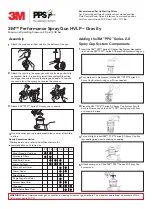
EN
SB-2-301-V (7/2014)
1 / 8
SERVICE MANUAL
MBC-510 SPRAY GUN
Repair Kit KK-4058-1
IMPORTANT: Before using this equipment,
read all safety precautions and instructions.
Keep for future use.
Note
This gun may be used with chlori-
nated solvents. Aluminum is not
used in the fluid passage areas.
DESCRIPTION
The MBC-510 standard spray gun has a
removable sprayhead; nickel plated brass
fluid passages; a stainless steel fluid tip and
needle to reduce wear; forged aluminum
gun body; large air and fluid passages for
high capacity use and a cartridge type air
valve to minimize repairs.
Nozzle combinations are listed in Chart 1.
Refer to the Spray Gun Catalog, I-2008, for
information regarding air cap and fluid tip
characteristics.
OPERATION
Strain material thru 60 or 90 mesh screen.
Adjust fluid pressure to deliver the desired
paint volume. Adjust air pressure and flow
to provide a uniform dispersion of atomized
paint throughout the pattern. Keep air pres-
sure as low as possible to minimize bounce
- back and overspray. Excessive fluid flow
will result in heavy center spray patterns.
Inadequate flows may cause the pattern
to split. See Spray Gun Guide, SB-2-001,
which is available upon request, for details
concerning set up of spray guns.
PREVENTIVE MAINTENANCE
To clean air cap and fluid tip, brush exterior
with a stiff bristle brush. If necessary to clean
cap holes, use a broom straw or toothpick.
Never use a wire or hard instrument. This
may scratch or burr holes causing a distorted
spray pattern.
To clean fluid passages, remove excess
material at source, then flush with a suit-
able solvent using a device such as the
SolventSaver™ (see Accessories). Wipe
gun exterior with a solvent dampened cloth.
Never completely immerse in solvent as this
is detrimental to the lubricants and packings.
Note
When replacing the fluid tip or fluid
needle, replace both at the same time.
Using worn parts can cause fluid
leakage. For thinner, less viscous
materials a lapped tip and needle set
is recommended. See Chart 3. Also,
replace the needle packing at this
time. Lightly lubricate the threads
of the fluid tip before reassembling.
Torque to 20-25 ft. lbs. Do not over
tighten the fluid tip.
To prevent damage to the fluid tip (5)
or fluid needle (11), be sure to either
1) pull the trigger and hold while
tightening or loosening the fluid tip
or 2) remove fluid needle adjusting
screw (32) to relieve spring pressure
against needle collar.
SPRAY GUN LUBRICATION
Daily, apply two drops of •SSL-10 spray gun
lube (see Accessories) at trigger bearing stud
(34) and the stem of the air valve (15) where
it enters the air valve assembly. The shank
of the fluid needle (11) where it enters the
packing nut (10) should also be oiled. The
fluid needle packing (9) should be kept soft
and pliable by periodic lubrication. Make
sure the sprayhead (8) and retaining ring (1
or 2) threads are clean and free of foreign
material. Before assembling retaining ring
to sprayhead, clean the threads thoroughly,
then add two drops of SSL-10 spray gun
lube to threads. The fluid needle spring (31)
and air valve spring (16) should be coated
with a very light grease, making sure that
any excess grease will not clog the air pas-
sages. For best results, lubricate the points
indicated, daily.
• Material Safety Data Sheet available from
DeVilbiss upon request.
A. Trigger Points
B. Packing
C. Adjusting Valves
D. Threads
AC D E EX FF FX
24 P
P
P
30
P S
P P
58
P/S S
P
P
62HD
P
64HD
P
69HD P
80 S
704
P
P
765
P
P
P
777
P
P
797
P
P
9000 S
CHART 1
Fluid Tip and Needle Sizes Order
From Chart 3
Air Cap Sizes
Order From
Chart 2
P - Pressure Feed Combination
S - Suction Feed Combination
Nozzle Combinations
24
AV-40-24
30
MB-4039-30
58
AV-439-58
62HD
MB-4039-62HD
64HD
MB-4039-64HD
69HD
MB-4039-69HD
80
MB-4039-80
704
AV-1239-704
765
AV-1239-765
777
31767-777
797
AV-1239-797
9000
AV-440-9000
Air Caps
CHART 2
A
B
A
C
D
No. on
Ref. Nos. (1)
Ref. No. (3)
Cap
Air Cap
Air Cap
Order
with Ring
Less Ring
CA PROP
65
PROP 65 WARNING
WARNING: This product
contains chemicals known
to the State of California to
cause cancer and birth
defects or other
reproductive harm.


























